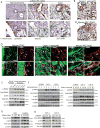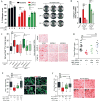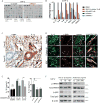Tumor-Stroma IL1β-IRAK4 Feedforward Circuitry Drives Tumor Fibrosis, Chemoresistance, and Poor Prognosis in Pancreatic Cancer
- PMID: 29363544
- PMCID: PMC5890818
- DOI: 10.1158/0008-5472.CAN-17-1366
Tumor-Stroma IL1β-IRAK4 Feedforward Circuitry Drives Tumor Fibrosis, Chemoresistance, and Poor Prognosis in Pancreatic Cancer
Abstract
Targeting the desmoplastic stroma of pancreatic ductal adenocarcinoma (PDAC) holds promise to augment the effect of chemotherapy, but success in the clinic has thus far been limited. Preclinical mouse models suggest that near-depletion of cancer-associated fibroblasts (CAF) carries a risk of accelerating PDAC progression, underscoring the need to concurrently target key signaling mechanisms that drive the malignant attributes of both CAF and PDAC cells. We previously reported that inhibition of IL1 receptor-associated kinase 4 (IRAK4) suppresses NFκB activity and promotes response to chemotherapy in PDAC cells. In this study, we report that CAF in PDAC tumors robustly express activated IRAK4 and NFκB. IRAK4 expression in CAF promoted NFκB activity, drove tumor fibrosis, and supported PDAC cell proliferation, survival, and chemoresistance. Cytokine array analysis of CAF and microarray analysis of PDAC cells identified IL1β as a key cytokine that activated IRAK4 in CAF. Targeting IRAK4 or IL1β rendered PDAC tumors less fibrotic and more sensitive to gemcitabine. In clinical specimens of human PDAC, high stromal IL1β expression associated strongly with poor overall survival. Together, our studies establish a tumor-stroma IL1β-IRAK4 feedforward signal that can be therapeutically disrupted to increase chemotherapeutic efficacy in PDAC.Significance: Targeting the IL1β-IRAK4 signaling pathway potentiates the effect of chemotherapy in pancreatic cancer. Cancer Res; 78(7); 1700-12. ©2018 AACR.
©2018 American Association for Cancer Research.
Conflict of interest statement
The authors declare no potential conflicts of interest
Figures







Similar articles
-
Constitutive IRAK4 Activation Underlies Poor Prognosis and Chemoresistance in Pancreatic Ductal Adenocarcinoma.Clin Cancer Res. 2017 Apr 1;23(7):1748-1759. doi: 10.1158/1078-0432.CCR-16-1121. Epub 2016 Oct 4. Clin Cancer Res. 2017. PMID: 27702822 Free PMC article.
-
Micro-RNA-21 Regulates Cancer-Associated Fibroblast-Mediated Drug Resistance in Pancreatic Cancer.Oncol Res. 2018 Jul 5;26(6):827-835. doi: 10.3727/096504017X14934840662335. Epub 2017 May 5. Oncol Res. 2018. PMID: 28477403 Free PMC article.
-
Periostin promotes the chemotherapy resistance to gemcitabine in pancreatic cancer.Tumour Biol. 2016 Nov;37(11):15283-15291. doi: 10.1007/s13277-016-5321-6. Epub 2016 Sep 30. Tumour Biol. 2016. PMID: 27696296
-
CAF Subpopulations: A New Reservoir of Stromal Targets in Pancreatic Cancer.Trends Cancer. 2019 Nov;5(11):724-741. doi: 10.1016/j.trecan.2019.09.010. Epub 2019 Oct 21. Trends Cancer. 2019. PMID: 31735290 Review.
-
Apoptosis in the Pancreatic Cancer Tumor Microenvironment-The Double-Edged Sword of Cancer-Associated Fibroblasts.Cells. 2021 Jul 1;10(7):1653. doi: 10.3390/cells10071653. Cells. 2021. PMID: 34359823 Free PMC article. Review.
Cited by
-
Modeling human pancreatic ductal adenocarcinoma for translational research: current options, challenges, and prospective directions.Ann Pancreat Cancer. 2020 Dec;3:17. doi: 10.21037/apc-20-29. Epub 2020 Dec 29. Ann Pancreat Cancer. 2020. PMID: 33889840 Free PMC article.
-
Exploiting Matrix Stiffness to Overcome Drug Resistance.ACS Biomater Sci Eng. 2024 Aug 12;10(8):4682-4700. doi: 10.1021/acsbiomaterials.4c00445. Epub 2024 Jul 5. ACS Biomater Sci Eng. 2024. PMID: 38967485 Free PMC article. Review.
-
The impact of cancer-associated fibroblasts on major hallmarks of pancreatic cancer.Theranostics. 2018 Oct 6;8(18):5072-5087. doi: 10.7150/thno.26546. eCollection 2018. Theranostics. 2018. PMID: 30429887 Free PMC article. Review.
-
NF-κB-Dependent Snail Expression Promotes Epithelial-Mesenchymal Transition in Mastitis.Animals (Basel). 2021 Dec 1;11(12):3422. doi: 10.3390/ani11123422. Animals (Basel). 2021. PMID: 34944199 Free PMC article.
-
CAFs-Associated Genes (CAFGs) in Pancreatic Ductal Adenocarcinoma (PDAC) and Novel Therapeutic Strategy.Int J Mol Sci. 2024 May 30;25(11):6003. doi: 10.3390/ijms25116003. Int J Mol Sci. 2024. PMID: 38892190 Free PMC article. Review.
References
Publication types
MeSH terms
Substances
Grants and funding
LinkOut - more resources
Full Text Sources
Other Literature Sources
Medical
Molecular Biology Databases

